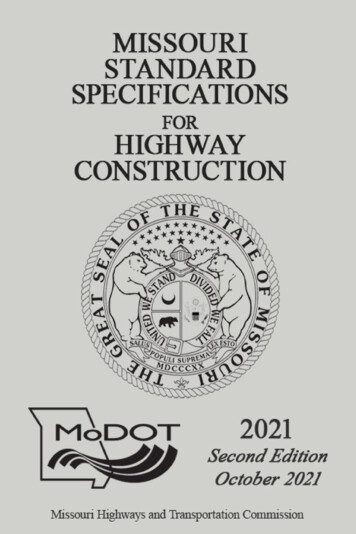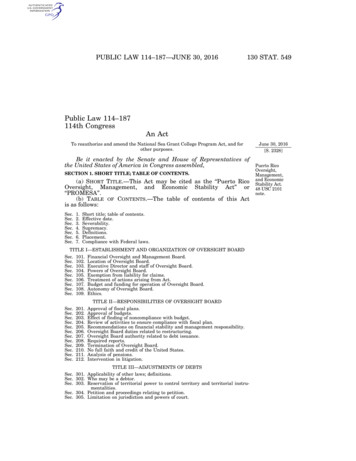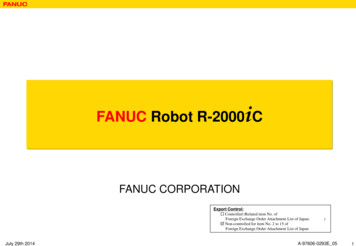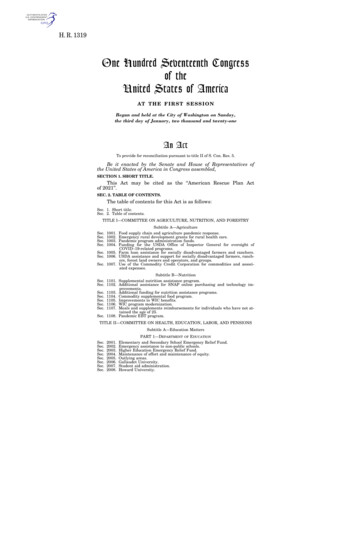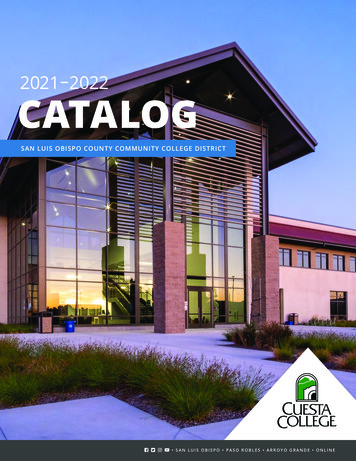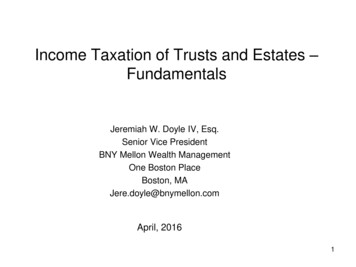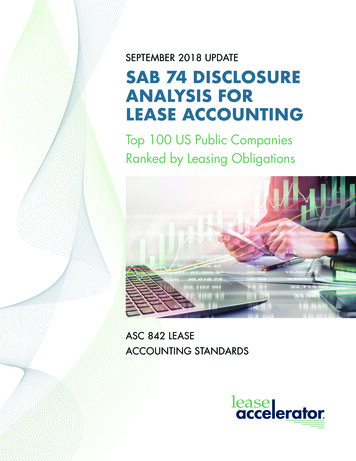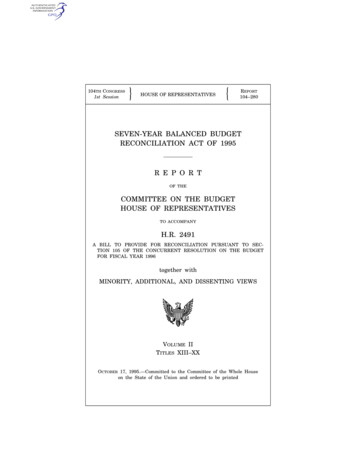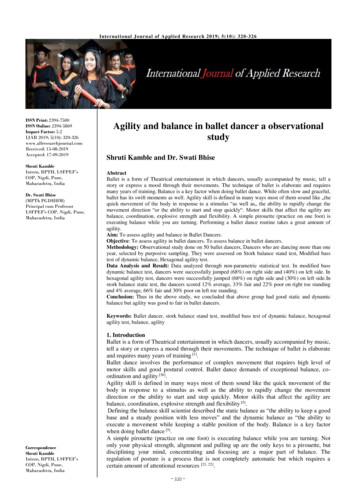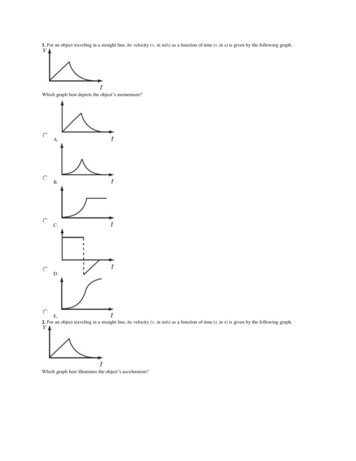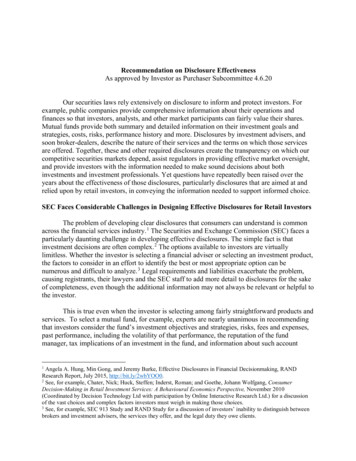
Transcription
Recommendation on Disclosure EffectivenessAs approved by Investor as Purchaser Subcommittee 4.6.20Our securities laws rely extensively on disclosure to inform and protect investors. Forexample, public companies provide comprehensive information about their operations andfinances so that investors, analysts, and other market participants can fairly value their shares.Mutual funds provide both summary and detailed information on their investment goals andstrategies, costs, risks, performance history and more. Disclosures by investment advisers, andsoon broker-dealers, describe the nature of their services and the terms on which those servicesare offered. Together, these and other required disclosures create the transparency on which ourcompetitive securities markets depend, assist regulators in providing effective market oversight,and provide investors with the information needed to make sound decisions about bothinvestments and investment professionals. Yet questions have repeatedly been raised over theyears about the effectiveness of those disclosures, particularly disclosures that are aimed at andrelied upon by retail investors, in conveying the information needed to support informed choice.SEC Faces Considerable Challenges in Designing Effective Disclosures for Retail InvestorsThe problem of developing clear disclosures that consumers can understand is commonacross the financial services industry. 1 The Securities and Exchange Commission (SEC) faces aparticularly daunting challenge in developing effective disclosures. The simple fact is thatinvestment decisions are often complex. 2 The options available to investors are virtuallylimitless. Whether the investor is selecting a financial adviser or selecting an investment product,the factors to consider in an effort to identify the best or most appropriate option can benumerous and difficult to analyze. 3 Legal requirements and liabilities exacerbate the problem,causing registrants, their lawyers and the SEC staff to add more detail to disclosures for the sakeof completeness, even though the additional information may not always be relevant or helpful tothe investor.This is true even when the investor is selecting among fairly straightforward products andservices. To select a mutual fund, for example, experts are nearly unanimous in recommendingthat investors consider the fund’s investment objectives and strategies, risks, fees and expenses,past performance, including the volatility of that performance, the reputation of the fundmanager, tax implications of an investment in the fund, and information about such accountAngela A. Hung, Min Gong, and Jeremy Burke, Effective Disclosures in Financial Decisionmaking, RANDResearch Report, July 2015, http://bit.ly/2wbYOO0.2See, for example, Chater, Nick; Huck, Steffen; Inderst, Roman; and Goethe, Johann Wolfgang, ConsumerDecision-Making in Retail Investment Services: A Behavioural Economics Perspective, November 2010(Coordinated by Decision Technology Ltd with participation by Online Interactive Research Ltd.) for a discussionof the vast choices and complex factors investors must weigh in making those choices.3See, for example, SEC 913 Study and RAND Study for a discussion of investors’ inability to distinguish betweenbrokers and investment advisers, the services they offer, and the legal duty they owe clients.1
features as investment minimums. 4 That is a daunting task, made more difficult by the fact thatsome of these factors – such as investment strategy and risk – can be difficult to convey in clearlanguage that the investor is likely to understand. In recent years, more complex products andservices have entered the retail marketplace, further complicating those choices. The morecomplex the product, the more difficult it becomes to convey the relevant information clearly.Further complicating the SEC’s task is the fact that many investors lack relevantknowledge needed to fully understand the disclosures designed to help them make investmentdecisions. For example, a review of studies and surveys on investor knowledge, prepared by theLibrary of Congress for the SEC, found that many investors do not understand key financialconcepts, such as diversification or the differences between stocks and bonds, and are not fullyaware of investment costs and their impact on investment returns. 5 In 2008, RAND Corporationresearchers studying the regulatory landscape for broker-dealers and investment advisers foundthat most investors who responded to their survey and participated in their focus groups,including those who had employed financial professionals for years, did not “have a clearunderstanding of the boundaries between investment advisers and broker-dealers.” 6 In addition,surveys demonstrate that certain subgroups, including women, African-Americans, Hispanics,the oldest segment of the elderly population, and those with lower education levels, have an evengreater lack of investment knowledge than the average person in the general population. 7In a white paper on retirement, Merrill Lynch describes the problem this way: “Peoplefind the language of finance confusing: Sixty-five percent of Americans say that most of thelanguage used by the finance industry is not user-friendly. The world of financial instrumentsand strategies can be complicated, and many people’s ‘financial IQ’ isn’t high. Only six in ten ofAmericans age 50 say they clearly understand the two terms most associated with saving forretirement—IRA and 401(k). Far fewer understand the process of asset decumulation or theproblem of 401(k) leakage.” 8 In short, the challenge the SEC faces is a daunting one: designingcomprehensible disclosures about complex topics for individuals who lack expertise in the topicand are uncomfortable with the vocabulary of finance.Many Investors Struggle to Understand DisclosuresThe SEC has devoted considerable time and effort over the years to a good faith effortaimed at developing more investor-friendly disclosures. Despite those efforts, however, evidencesuggests that many investors still struggle to understand the disclosures they receive aboutinvestments and investment professionals. Perhaps the most comprehensive study of this issueRoper, Barbara, Mutual Fund Essential Knowledge: What Do Investors Need to Know and What is the Best Way toProvide that Information? (2005).5Seth L. Elan, Financial Literacy Among Retail Investors in the United States, A Report Prepared by the FederalResearch Division, Library of Congress under an Interagency Agreement with the SEC, December 30, 2011,http://bit.ly/2eK31CA. See, also, FINRA Investor Education Foundation, Investors in the United States 2016, Dec.2016, http://bit.ly/2hMrppX (“FINRA Survey”).6Angela A. Hung, et al., Investor and Industry Perspectives on Investment Advisers and Broker-Dealers. SantaMonica, CA: RAND Corporation, 2008, http://bit.ly/1OrrZ3v.7Elan, Financial Literacy Among Retail Investors.8Finances in Retirement: New Challenges, New Solutions, A Merrill Lynch Retirement Study, conducted inpartnership with Age Wave 2017 https://bit.ly/34hJeD7.42
was conducted in 2012 on behalf of the SEC. 9 That study included a number of questionsdesigned to test investors’ ability to understand a variety of common disclosures. The onlinesurveys conducted for the study found, for example: Among survey respondents who reviewed a sample ADV Form, fewer than three in ten(28.9 percent) were able to correctly identify the likely amount they would be charged,based on the information presented in the exhibit they reviewed. 10 Among survey respondents who reviewed a sample confirmation for a mutual fundtransaction, less than two-thirds (57.9 percent) could correctly identify the type ofinvestment, and only 12.7 percent recognized that the financial firm was acting as a dualagent. 11 Having reviewed a sample disclosure that begins as follows, “In addition to sales loadsand 12b-1 fees described in the prospectus, we receive other compensation ,” just overhalf (54.8 percent) correctly answered a question about whether the firm getscompensation other than sales loads and 12b-1 fees. 12 After reviewing a sample chart providing information on additional payments the firmreceives from mutual fund companies, only 31.8 percent indicated they definitely knewwhat the term “annual asset fees” meant, and another 46.2 percent indicated they thoughtthey knew what it meant. 13 Survey respondents were generally unable to determine thesignificance of the information provided. 14These findings are consistent with other research conducted on behalf of the SEC to testindividual disclosures. In 2005, for example, focus group tests conducted by Siegel & Gale LLCof a proposed disclosure for fee-based brokerage accounts concluded that the proposeddisclosure left investors “confused as to the differences between accounts and the implications ofthose differences to their investment choices.” 15 More recently, RAND Corporation testing of theproposed Customer Relationship Summary (CRS) for broker-dealers and investment advisersfound that, while investors generally viewed the disclosures favorably, many investors failed tounderstand key information that would help them determine whether a brokerage or advisoryaccount would best suit their needs even after a careful reading of the CRS. 16Siegel Gale, Investor Research Report, Submitted to the U.S. Securities and Exchange Commission, July 26,2012 l-literacy-study-part3.pdf.10SEC Investor Research Report, page 89 and 91.11Ibid, page 134.12Ibid, page 172.13Ibid, page 277.14Ibid, page 278.15Siegel and Gale, LLC, and Gelb Consulting Group, Inc., Results of Investor Focus Group Interviews AboutProposed Brokerage Account Disclosures: Report to the Securities and Exchange Commission, March 10, 2005,http://bit.ly/2wXS33l.16Angela A. Hung et. al., Investor Testing of Form CRS Relationship Summary, prepared by the RANDCorporation for the Securities and Exchange Commission, Nov. 2018, https://bit.ly/2QxcRfj (“RAND 2018”). See,also, Letter from AARP, CFA, and the Financial Planning Coalition to SEC Chairman Jay Clayton, September 12,2018, https://bit.ly/2CXfz6W.93
Despite Improvements, Current Disclosures Often Fail to Match Investor Needs andPreferencesAs the SEC financial literacy study and other research has shown, investors wantdisclosures that are brief, readable and delivered before they have to make an investmentdecision. The SEC study found, for example, that: Investors “favor summary documents containing key information about the investmentproduct.” 17 Investors “prefer that disclosures be written in clear, concise, understandable language,using bullet points, tables, charts, and/or graphs.” Investors “prefer to receive disclosures before making a decision on whether to engage afinancial intermediary or purchase an investment product or service,” ideally receivingthat information far enough in advance to think about it before making a decision.The Commission has adopted numerous improvements over decades of effort, includingsummary prospectuses for mutual funds, plain English requirements and comparison toolsintended to address these concerns. However, investors still often receive long, densely wordeddocuments – documents written by lawyers to comply with legal requirements – after they havealready made the investment decision and, sometimes, after the transaction has already beencompleted.For example, mutual fund prospectuses, fund shareholder reports, and ADV forms can allbe dozens of pages long, and sometimes top 100 pages. Prospectuses for variable products aretypically even longer. As a result, investors may end up feeling overwhelmed by the volume andcomplexity of the information they receive, and that may translate into confusion regarding thechoices they face. According to a 2012 survey of investor sentiments, for example, 40 percent ofinvestors believe investment products are “overly complex,” and 34 percent feel “overwhelmed”by the investment choices available to them. 18This directly undermines disclosure effectiveness, as research in the decision-makingliterature suggests that “consumers tend to reduce the amount of effort they expend whendecisions become more complex.” 19 Similarly, another study of the insurance market finds that,“More information may deflect attention from what is really important. A pervasive finding isthat cue competition occurs: more salient cues weaken the effects of less salient ones, and thepresence of irrelevant cues causes subjects to make less use of relevant cues. IntroducingResearchers who have tested disclosure documents with investors have reached similar findings. See, forexample, Greenwald, Mathew, Report on Consumer and Financial Advisor Reaction to Annuity DisclosureDocuments: A Report on Seven Focus Groups and Four In-depth Interviews, prepared for ACLI by MathewGreenwald & Associates; also, ICI, Investor Views.18MFS Investments news release, “Complexity of Investment Products Overwhelming Investors” (May 7, 2012).19Agnew, Julie R.; Anderson, Lisa R.; Gerlach, Jeffrey R.; and Szykman, Lisa R., An Experimental Study of AnnuityChoice (June 2008)174
additional accurate information may therefore lead to worse outcomes.” 20 In other words,providing more information, even when that information is accurate and relevant, may actuallycause investors to make less use of the information.This creates a tension between the various purposes served by disclosure. Markettransparency, accountability, and regulatory oversight depend on the full and fair disclosure ofall material information that has characterized the Commission’s traditional approach. Moreover,investors may benefit from disclosures they do not read, if, for example, independent analystsand reporting services digest and summarize the material, thereby enabling investors to focus onkey insights they might have otherwise missed. In some cases, the information required to bedisclosed causes entities to avoid conduct that would be embarrassing if revealed. Similarly,comprehensive 10(k) disclosures by issuers lead to more accurate pricing of their securities,benefiting even those investors who do not review the 10(k).But designing effective disclosures to assist retail investors in choosing a mutual fund ora financial professional may require a different approach. To address this concern, theCommission has experimented with the creation of summary disclosures in areas most importantto retail investors in order to supplement the longer disclosure documents. The mutual fundsummary and the CRS are two such examples. Most recently, the Commission adopted proposedrule to create a summary disclosure for variable products. Even where the Commission makes agood faith effort to create a plain English summary disclosure, however, better outcomes wouldbe possible if the Commission were to incorporate basic principles of effective disclosure designinto the development of these disclosures. 21Improving the Quality of SEC’s Retail Disclosures is an Achievable GoalDesigning effective disclosures for individuals who are not comfortable with thelanguage of finance poses significant challenges. And there are limitations to what one shouldexpect to achieve through disclosure alone. 22 On the other hand, disclosure experts have learneda lot in recent years about how to design disclosures to increase the likelihood both that they willbe read and that they will be understood. The IAC heard presentations on how to design effectivedisclosures from experts in the field at its September 19, 2019 meeting. 23 Although the panelistsapproached the topic from very different perspectives, there was broad agreement that it ispossible to design clear disclosures of complex topics for a non-expert audience. There was also20De Meza, David; Irlenbusch, Bernd; Reyniers, Diane; Disclosure, Trust and Persuasion in Insurance Markets,Institute for the Study of Labor (IZA), Discussion Paper No. 5060 (July 2010)21See, e.g., Hypothetical Initial Summary Prospectus for a Variable Annuity Contract, prepared by SEC Staff toillustrate its rule proposal, ppendix-a.pdf.22McCabe Curwood, Disclosure is Not Enough, Oct. 19, 2019 .23We heard from the following panelists: Brenda J. Cude, Professor, Department of Financial Planning, Housingand Consumer Economics, University of Georgia; Billy Kingsland, Group Director, Brand Communication,Siegel Gale; Dan Silverman, Rondthaler Professor of Economics, Arizona State University, Research Associate,NBER; Yuhgo Yamaguchi, VP, Design Strategy, Fidelity Labs, Fidelity Investments. Meeting webcast availablehere: html?document id iac091919. Susan Kleimann alsoaddressed this topic during an earlier panel discussion on the SEC’s proposed Form CRS June 24, 2018. The slidesfrom her presentation are available here: .5
broad agreement, however, that improved disclosure design is only likely to be achieved if basicprinciples of effective disclosure are built in on the front end. The following are among the mostimportant of these principles, as identified by the panelists: Disclosures need to be designed with a clear understanding of the end user. Research, inthe form of surveys and focus groups, can help to clarify investors’ needs and wants.However, “human-centered design” is “not just about asking people what they want anddelivering it. It’s about understanding people, what they mean, what they value beyondwhat they can articulate in a focus group or a survey.” 24 Disclosures also need to be designed with a clear understanding of the purpose thedisclosure is intended to achieve. They are most likely to be effective if they are based ona consumer empowerment goal. Toward that end, those designing the disclosures shouldask themselves, “What are you trying to enable investors to do as a result of thesedisclosures?”25 One key purpose of disclosures is to support investor decision-making. Enabling clearcomparisons and highlighting key differences in the disclosure is important, because“comparing things is how we make decisions.” 26 Moreover, presenting disclosures in aquestion-and-answer format can help to guide them through that decision-makingprocess. Experts in disclosure design should be involved in the disclosure development processfrom the beginning, working hand-in-hand with legal experts. Relevant disclosure designexpertise includes how to choose and create content, design the disclosure, and determinewhen and how best to deliver the disclosure. Consumer testing is necessary to understand how the disclosures are likely to be used andunderstood and whether they achieve their intended goal. One-on-one cognitiveinterviews are a useful technique to help demonstrate what consumers want to knowabout a topic, what they think the disclosure is telling them, and whether they’ll use it andhow. 27 Another useful technique is A/B testing, which allows comparison of differentapproaches and how consumers respond to those approaches. 28 The results of that testing should be used to refine the disclosure design. Disclosures aremost likely to be effective if they are developed through an iterative process thatincorporates research, design, testing, revision, and retesting.See remarks of Yuhgo Yamaguchi. This point was also emphasized by Billy Kingsland.See remarks of Brenda Cude.26See remarks of Yuhgo Yamaguchi.27For online disclosures, heat mapping can help to demonstrate how users interact with a disclosure.ee, sing-heatmaps-studies/. “A heat map uses a warm-to-cool colorspectrum to show you your site analytics, namely which parts of a page receive the most attention.”28See remarks of Billy Kingsland.24256
Disclosure timing is important. Disclosures that arrive after the investor has made theirdecision are less likely to be read or, if read, to influence investor behavior. 29 Technological advances allow for non-traditional approaches to disclosure, such as theuse of videos and info-graphics. Similarly, electronic delivery (either online or throughmobile apps) allows for just-in-time delivery of disclosures. However, not everyone hasaccess to these technologies. Moreover, as technology lowers the cost of disclosure, it canlead to the disclosure of more and more information, which can distort investors’choices. 30 Standardization of disclosures can benefit investors, by making comparisons easier, andcompanies, who do not each have to reinvent the wheel in responding to a new disclosuremandate. 31 These potential benefits of standardization have to be balanced againstconcerns about one-size-does-not-fit-all disclosures. One option is for the regulator togive companies a template, and a clear sense of how they fill that in, but with the abilityto adjust it to fit their particular situation. 32 Layering of disclosures offers a key way to resolve the tension between the demand forcomprehensive information (to inform the market and more sophisticated users, tocomply with legal obligations, and to address liability concerns) and the need tocommunicate clearly to retail investors. Instead of thinking of layering in binary terms,where one layer consists of a brief summary and a second layer consists of the fullprospectus, disclosures can be designed as a decision-tree to help walk the user through acomplex process or as a spectrum of information, delivered in bite-size pieces. 33One point that was emphasized throughout the panel was the importance of using aniterative process to research, design, test, and refine disclosures. As Kingsland said, “Culturallywithin the SEC we would just encourage that that become your go-to process.” Similarly,Yamaguchi stated, “That’s an important process to follow, because if we just start with ourhypotheses and then put them in the market wholesale, then we’re in a sense just guessing, andwe don’t want to do that.” Panelists also emphasized the importance of including design expertsin the process from the outset, working with the legal experts. “Where we see things go awry,”Kingsland said, “is either legal is the only department holding the baton or legal gets passed thebaton at the very end of the process and they’ve not been involved from the beginning andnecessarily it undoes all the work that came before.”While the Commission has increasingly incorporated consumer research into itsdevelopment of disclosures, and has looked to layered disclosures as a way to develop moreinvestor-friendly disclosures, it has not typically used the kind of iterative process identified bypanelists as critical to the development of effective disclosures. This suggests that proceduralSee remarks of Brenda Cude.See remarks of Dan Silverman.31See remarks of Dan Silverman.32See remarks of Brenda Cude.33See remarks of Brenda Cude and Yuhgo Yamaguchi.29307
changes in the Commission’s approach to disclosure development could result in significantimprovements in the effectiveness of its mandated disclosures.RecommendationIn order to enhance the effectiveness of disclosures that are aimed at and relied onprimarily by retail investors, the IAC makes the following recommendations: In developing new disclosures intended primarily for retail investors, the SEC should, tothe extent possible, adopt an iterative process that includes research, design, testing, andrefinement of proposed disclosures. In addition to incorporating this process into its ownwork, the Commission could provide incentives to registrants who employ these bestpractices in their disclosure development. Disclosure design experts should work hand-in-hand with legal experts throughout thedisclosure development process to provide input into decisions about content, language,presentation, and delivery. In developing disclosures, they should seek to balance thebenefits of standardization against the risks of one-size-fits-none disclosures. In addition to using this process for development of new disclosures, the Commissionshould, as resources allow, review existing retail disclosures (such as various mutual funddisclosures, the new variable product summary, the CRS and ADV, and possibly IAPDand BrokerCheck reports) to determine their effectiveness and, as necessary, makeimprovements. In deciding which disclosures to review, the Commission should prioritize thosedisclosures or sections of disclosures that its research shows are of greatest significanceto retail investors and/or least likely to be read or understood by such investors. TheOffice of Investor Advocate can play a valuable role in helping to set those priorities. The Commission should continue to explore the potential for alternative disclosureformats (e.g., online, video, mobile app) to improve investor engagement andcomprehension, providing registrants appropriate regulatory relief that may be necessaryto encourage those innovations. Of course, the Commission should preserve easy accessto paper documents for those who prefer that delivery method. Regardless of whether the Commission develops in-house expertise in this area, relies onoutside consultants, or some combination of the two, it will require an appropriateallocation of resources. Congress should provide the agency with the personnel andresources necessary to support this effort.The IAC believes that adopting these changes can meaningfully improve the effectiveness ofinvestor disclosures, with potential benefits for investors, financial firms, and the market as awhole.8
and 12b-1 fees described in the prospectus, we receive other compensation ," just over half (54.8 percent) correctly answered a question about whether the firm gets compensation other than sales loads and 12b-1 fees.12 After reviewing a sample chart providing information on additional payments the firm
